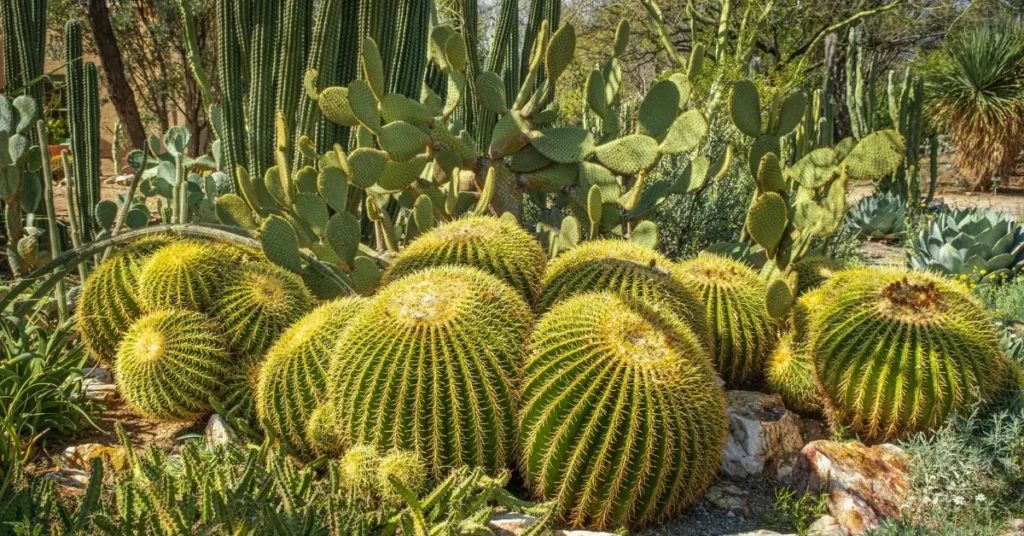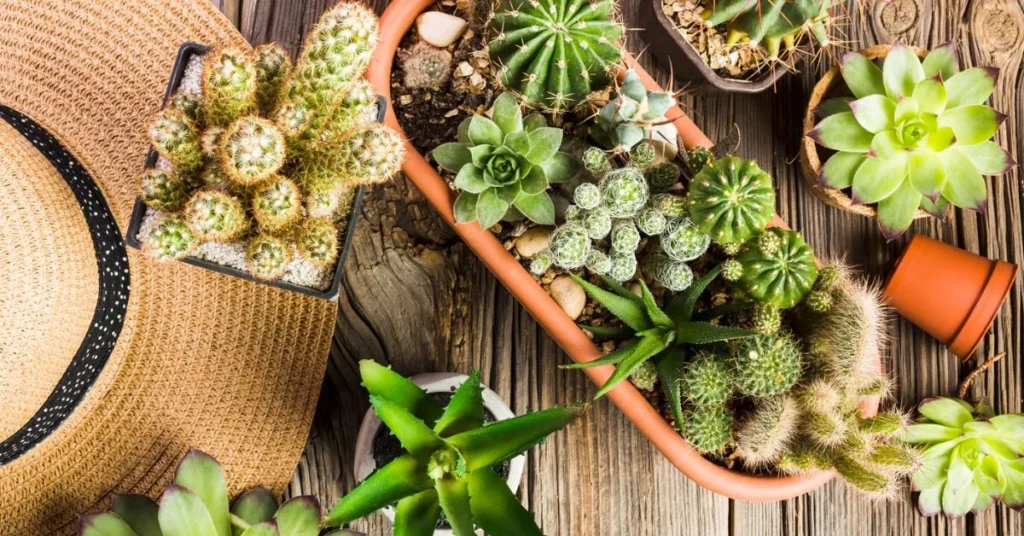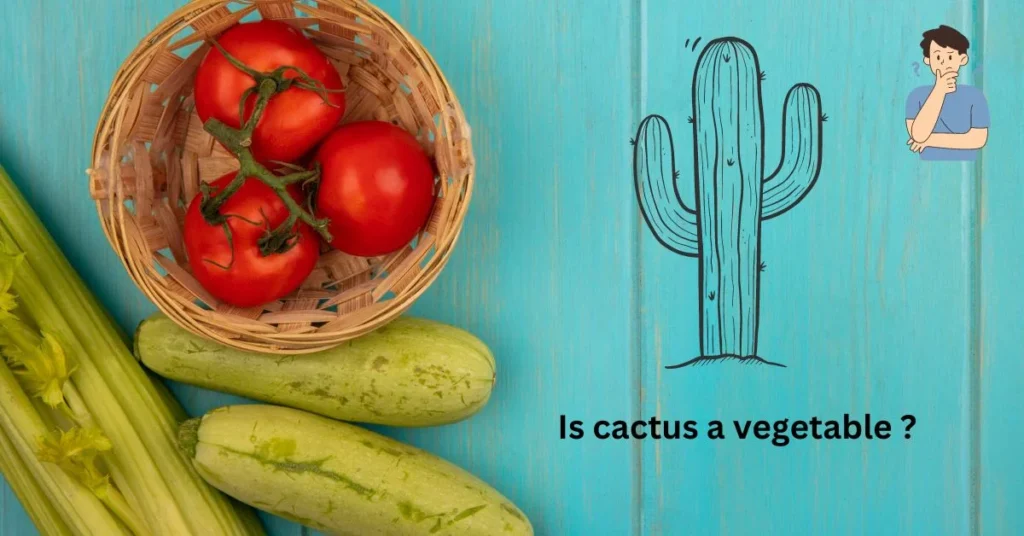In this post, I’m going to explain if cactus is a vegetable or not?
The answer is: It depends.
In fact, research shows that some cacti have unbelievable benefits while some are poisonous.
In this post, you’ll come to know:
- Vegetable Cacti
- Fruit Cacti
- Species Name
- Etymology
- Human Consumption
- Morphology
- And
- Cultivation
Let’s explore…
Cactus as Vegetable

Majorly, Nopals (Scientific Name: opuntia) species are a source of food. Two major types of opuntia species that are used as vegetables are Opuntia ficus-indica and Opuntia cochenillifera.
These are tropical and subtropical plants that can be extensively grown as a crop. The details on various vegetable cactus plants are given below;
Prickly Pear Cactus
Species Name: Prickly Pear Cactus is scientifically known as Opuntia ficus-indica ( genus: Opuntia, subfamily: Opuntioideae, family: Cactaceae). Commonly, it is known as Indian fig opuntia, cactus pear, or prickly pear cactus.
Cultivation: From an early age, people in Mexico, Asia, the United States, South America, Africa, the Mediterranean, and North America cultivated different varieties of opuntia and used them as food, fodder, nutraceutical compounds, etc. Both the stems and the fruit are edible.
Human Consumption: The leaves of the plant (commonly called cladodes) are a major source of food for the people. You can chop up the stem and leaves portion and make salad or use in fried meat dishes.
These plants feature a slimy nature upon eating. This is due to the blending of malic acid and polysaccharides.
Sugars, total solids content and vitamins levels in the stem and fruit continuously increase as the plant grows. It depends on the soil and the water routines. The fruit of the plant is also edible.
It tastes like a fresh juicy watermelon. The fruit is also known as tuna in major countries. The spines on the tuna or leaves need to be removed before eating.
Uses in Industries: Cladodes are also used in processed food industries and cosmetic industries. It is used as a preservative for pickles or raw material for supplements or cosmetic products. You can also use it in making jellies and syrups.
Environmental Effect: The growth of the fruit dramatically increases depending on the environment of the countries. The change in pH is notable as the color of the fruit also changes with time.
Fodder: The use of prickly pear cacti as fodder has increased in the past years. In the US, people cultivate the opuntia to be used as food for animals or as boundary fences.
The spines of the plant are burned in severe cases but they are required to be removed before use as fodder.
Cochineal Nopal Cactus
Species Name: Cochineal Nopal cactus is scientifically known as Opuntia cochenillifera. (genus: Opuntia, subfamily: Opuntioideae, family: Cactaceae). Commonly, it is known as Cochineal Cactus, Velvet Opuntia, Wooly Joint Prickly Pear, or Nopal Cactus.
Etymology: You may have thought why we call it Cochineal cactus? Cochineal insects reside on the bright red fruit portion of the plant. The fluids excreted by the insects gave the fruit a reddish appearance.
They are a major source of dyes in dye industries as well. The Crimson name is derived from the cochineal plant. Crimson or carmine dye comes from the cochineal plant.
Cultivation: Cochineal cacti are largely present in Mexico and many areas of India, Africa and North America. These species are thornless and give a smooth feel when touched. Since the 1880s, the plant has been widely cultivated to be used as food.
Human Consumption: The leaves are used as vegetables. It is easy to grow them as they require little or no water. People in various countries widely use them as salad and also cook it to form various delicious dishes.
Fodder: It is also used as animal food. The leaves and fruit are edible. As they are thornless, it reduces the workload of utilizing cactus as a source of food.
If you look closely, the green part below the fruit possess spines that are rigid and may harm the person. So, take care while using the plant as a source of food.
Cowboy’s Red Whiskers
Species name: Cowboy’s red whiskers are scientifically known as Opuntia aciculata. (genus: Opuntia, family: Cactaceae). Commonly, it is known as Chenille prickly pear or old man’s whiskers.
The catchy common name of this plant comes from its origin in Texas. It is also widespread around the South Western USA and North of Mexico. It is a beautiful showcase plant that can enhance the beauty of any garden.
Etymology: There are multiple reasons for giving these species-specific names. Acicula means “small pins for headdress”. As it is covered with small pin-like spines, the name Chenille prickly pear was given to this species.
Also, the spikes look like the whiskers of a cowboy when it takes on a reddish color after growing.
Flowers: The plant produces bright bright red-orange colored flowers. They are folded which makes them deciduous. There are almost no spikes in this part of the plant.
Human Consumption: The stems and leaves of the cactus are largely consumed as vegetables. You can cook them after removing the spines from the thick body. These plants are also used in medicine and veterinary industries. It can be used to treat swelling and bruises.
Fodder: People also preferred to use it as fodder for their animals. The spikes can be burned off giving a clean plant at the end. The leaves are awl-shaped up to 7 mm long.
Cultivation: The plant gained popularity as it can be grown with a grafting system. It is a low-maintenance plant and can tolerate dry conditions. Prolonged drought can greatly harm the plant as well.
Cactus as Fruits

Numerous species are available that can be eaten as fruits. Some required the spines to be removed before eating them. The human requirement for valuable minerals and vitamins can be completed by eating the fruits of the cactus plants.
Fairy Castle Cactus
Species Name: Fairy Castle Cactus is scientifically known as Acanthocereus tetragonus. (genus: Acanthocereus, subfamily: Cactoideae, family: Cactaceae). Commonly, it is known as the Night-blooming Cereus, Barbed-wire Cactus, Sword-pear Dildo Cactus, and Triangle Cactus.
Etymology: The name originates from the castle-like appearance of the plant. Its stems are dark green and areoles are gray with two or three spines. The flowers are large with a greenish-white appearance.
Distribution: The cactus plant is located majorly in the Florida and Texas areas of the United States. Other countries include Mexico, South America, Central America and Caribbean etc.
Human Consumption: The traits of the cactus plants are modified to design a plant that is beneficial. Thus making the fairy castle cactus a cultivar plant.
The fruit of the plant is edible. It is sweet and juicy. The stems of the plant are also edible in raw or cooked form.
Cultivation: The cultivation of the fairy castle cactus is not difficult. The plant grows in tropical and subtropical areas with little supply of water. It is commonly grown as a house plant due to its beautiful structure and flowers.
Dragon Fruit
Species Name: Dragon Fruit is scientifically known as Selenicereus undatus. (genus: Selenicereus, subfamily: Cactoideae, family: Cactaceae). Commonly, it is known as Pitaya or Pitahaya, Common Night Blooming Cereus, and Red Skin Dragon Fruit.
Cultivation: If you are exploring different edible cacti, this will surely be the one to check out. Originating from Mexico, South America, Guatemala and El Salvador, this fruit is now found in India, Africa and the United States as well.
Taste & Appearance: Dragon fruit has gained a lot of popularity due to its distinctive look and incredible taste. From the outside, scales are pink and yellowish in color, but inside, a colored edible portion with black seeds is present. It tastes somewhat similar to a pear or a kiwi.
In Mexico, it is referred to as “Pitaya” or “Pitahaya”. The plant has vast spread branches up to thirty feet or longer. It spreads all around the plant’s area.
The flowers give out a beautiful scent as well. Yellowish colored flowers are very pleasant to look at.
Human Consumption: Dragon fruit is edible as a fruit or can be cooked as a vegetable as well. You can cook it with its cover, and it will be softer from the inside. Dragon fruit is now a must-have for bars when preparing cocktails, fruit bars, etc.
Types: The dragon fruit has many types, which are;
- Pink Dragon fruit
- Yellow Dragon fruit
- Red Dragon fruit
- Sour Dragon fruit
- White Dragon fruit
Benefits: It is full of nutrients like vitamins, iron, magnesium, etc. It also has anticancer properties. You should at least try dragon fruit once in your life. I am sure it will be worth it!
Barrel Cactus
Species Name: Golden Barrel Cactus is scientifically known as Echinocactus grusonii. (genus: Ferocactus & Echinocactus, family: Cactaceae).
Etymology: In Spain, it is known as Venzaga, which means fat. It comes from its barrel-like round shape. It has spines all over its body that protect the fruit as well.Barrel cactus is native to New Mexico and North America.
Morphology: The fruit can reach a size between one to three meters. Differences in the color of the spike can tell us about the age of the barrel cactus.
Types: The cactus has many famous types. The most well-known is the golden barrel cactus. Other types of barrel cactus plants are as follows;
- Crested Golden Barrel Cactus
- Blue Barrel Cactus
- White Barrel Cactus
- Fire Barrel Cactus
- Coville’s Barrel Cactus
- Schwarz Barrel Cactus
- Texas Barrel Cactus
- Red Barrel Cactus
- Fish Hook Barrel Cactus
Flowers: Barrel cactus plant blooms with yellow or orange flowers. Pink and red flowers are also observed but are not common species of this plant. The flowers can be seen on the upper side near the tube area of the caucus plant.
Protection: These plants can bear harsh environments and their spines protect the fruit. Their shelf life is almost a year due to their structure.
Uses: The spines protect the plants from the thirsty desert creatures.The spines of the barrel cactus plants are also used as sutures, fishing hooks and needles.
Human Consumption: The fruit of the barrel cactus is inside the spine structure. Underneath the green colored shell, a soft edible portion is present.
The fruit is not as sweet as other cacti fruits but the bitter taste is also good to eat. The Americans also use these cactus plants as candy.
Prickly Pear Cactus
Species Name: The prickly pear cactus is scientifically known as Opuntia ficus-indica ( genus: Opuntia, subfamily: Opuntioideae, family: Cactaceae). Commonly, it is known as Indian fig opuntia and cactus pear.
Cultivation: As described earlier, this plant is majorly used as a crop plant. Asians, Americans and Mexicans have greatly utilized these cactus plants to fulfill their food requirements.
Fuit: The fruit of the prickly pear plant has different colors. The most common are white, yellow, red, brown, and green. The hue of the fruit depends on the species of the plant.
Human Consumption: Fully ripened fruit tastes like a berry or melon. These cactus fruit plants have huge nutritious benefits for the people. Anti-inflammatory and antioxidant properties are present in the fruit of the prickly pear cactus plants.
They are also edible by blending with other natural products to give them a better taste.
Benefits: Prickly pear fruit has huge potential to reduce the cholesterol level in the human body. Several nutrients that are needed for the human body like potassium, carbs, fibers, magnesium or vitamin C, all these can be present inside the fruit of prickly pear plants.
Nylon Hedgehog Cactus
Species Name: Nylon Hedgehog cactus is scientifically known as Echinocereus viridiflorus (subfamily: Cactoideae, family: Cactaceae). Commonly, it is also known as Green Pitaya and Small-flowered Hedgehog Cactus.
Genus: Echinocereus is a genus of small to medium-sized cactus plants. Almost sixty species of this genus are edible. The nylon hedgehog cactus is one of them.
Etymology: The name of the plant originated from its shiny spines and the green colored flowers.
Morphology: Nylon hedgehog cactus has flowers with a maximum length of up to 4 cm. It is a small-sized plant yielding a sweet and edible fruit. The plant has a small-sized fruit that is covered with spines. That makes it difficult to separate the fruit.
Cultivation: It is commonly located in the North of Mexico and the Central United States. Its habitat is dry environments and woodlands. These cactus plants need constant watering for proper ripening of the fruits.
Sunlight is also necessary but continuous exposure for a long time may dry the plants as well. So, we need to properly care for the plant to get the desired edible fruit portion.
Human Consumption: The fruit of the plant is also green in color and sweet in taste. People prefer to taste different types of hedgehog cactus plants. The fruits are nutritious and beneficial to the human body.
Final Verdict
To answer the question of whether cactus is a vegetable or not, I have quoted examples of different cacti that are used as vegetables and fruits as well. It depends on the species of cactus to which you are referring.
Certain species have stems and leaves that are edible. It makes the cactus plants a vegetable. But some other vegetable plants have fruits as well. Cacti with only fruits are also present.
Overall, it’s up to the properties of the cactus plants that you want to know about. After reading this blog post, you will have sufficient information about which cacti are vegetables and which are fruits. It will surely provide you with a comprehensive answer to your queries.
Here you have the answer:
Some species of cactus are vegetables while others are not.
And
Do you agree with the answer?
If not
Then let me know your answer in the comment section.
